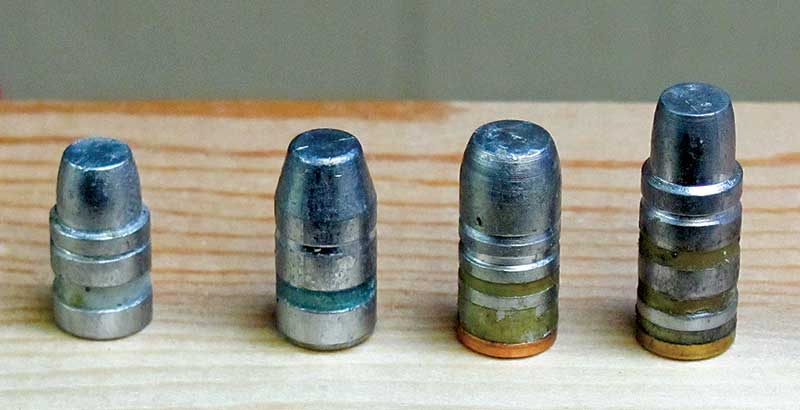Heavyweight Bullets In The .357 Magnum
One of the first manufacturers to offer suitable silhouetting sixguns was Dan Wesson, with their 8″ and 10″ heavy-barreled .357 Magnum. These were superbly accurate revolvers, however there were problems. An occasional pig, and not so occasional ram, would quiver and then settle back down without toppling, even when hit dead center with a full-house load with a 158-gr. jacketed .357 Magnum bullet. We soon learned the answer was a heavier bullet, however another problem surfaced, which was the lack of suitable bullets. It would take a while for manufacturers to offer 180- and 200-gr. full metal jacket .357 Magnum bullets, and even bullet casters found they had little to choose from. One bullet placed in the service was the RCBS #35-200FNGC (flatnosed gas check) designed for the .35 Remington lever-action rifle. It had the weight, but it was also overly long for the cylinder of the .357 Dan Wesson.
The solution was to seat it deeply in .38 Special brass. This, of course, did not leave much room for powder, however we were able to get muzzle velocities of around 900 fps. When shooting at 225 yards it seemed like it took forever for that bullet to reach the rams, but when it got there it did the job! That slow-moving, heavy bullet never failed me. It took down every pig and ram I hit. If I didn’t hit, it was not the fault of the bullet or the sixgun. That was the beginning, and we soon had heavyweight bullets available from a variety of makers.
Straightforward
It wasn’t only silhouetters who discovered the capability of heavyweight bullets in the .357 Magnum. Handgun hunters also soon found heavyweight bullets were more accurate and penetrated deeper in game. Muzzle velocities in revolvers were certainly slower, and quite a bit so, however the heavy bullets could be driven at very respectable speeds in the Thompson/Center Contender, as well as leverguns.
Loading heavyweight bullets in the .357 Magnum is pretty straightforward and handled the same as loading standard-weight bullets except for two things. We have to realize the powder capacity is reduced, so great care is needed not only in what powder is chosen but also how much is to be used. A second problem is overall cylinder length. Before loading a significant number of heavyweight .357 Magnum loads it’s a very good idea to make sure the bullet selected does not protrude past the front end of the cylinder when crimped in the crimping groove.
If I had to pick only one powder for heavy bullets in the .357 Magnum, or even in the .44 Magnum or .45 Colt for that matter, it would be either H110 or WW296, but more common powders can work too. My most used powder charge with either one of these excellent powders is 13.0 grains, when using bullets weighing from 180 to 210 grains in the .357 Magnum. These are both ball powders and magnum primers are absolutely required for proper ignition. With #2400 and #4227 I pretty much lean to standard primers with the former, and magnum primers with the latter.
Heavy Is Accurate
Imostly stay with gas check bullets in all .357 Magnum loads simply because they seem to shoot a lot more accurately. For most of my big-bore sixgun loads I use straight wheelweights for loads under 1,100 fps; however, with the smaller diameter .357 Magnum bullets I prefer a harder alloy and normally mix lead and type metal in equal amounts.
A heavyweight bullet I’ve used for several decades is Lyman’s 210-gr. Keith-style gas check bullet #358627. A new favorite is the NEI #358.200GC. This is a 200-gr. wide flatnosed, gas check bullet, and with its 4-cavity aluminum mold, casting is fast and the light weight of the aluminum reduces the fatigue factor significantly.
Commercial bullets available are a 187-gr. WFN gas check from Cast Performance Bullet Company, while Oregon Trail offers a plain-based 180-gr. bullet. Loaded over 11.0 grains of #2400, muzzle velocity is around 1,100 fps from my 10″ Ruger Flat-Top, with excellent accuracy.
Suppose one wants to shoot heavyweight bullets in a .357 Magnum sixgun and doesn’t cast bullets or even reload? DoubleTap has two excellent heavyweight bullet loads available using 180- and 200-gr. gas check bullets. They shoot right at 1,400 fps in my 10″ Rugers and are exceptionally accurate. Grizzly Ammo also offers a 180-gr. load which I use in my 71/2″ Freedom Arms .357 Magnum. This load is also very accurate, with a muzzle velocity in excess of 1,400 fps. After much use, it’s obvious to me, heavy bullets in the .357 Magnum can be extremely accurate.







